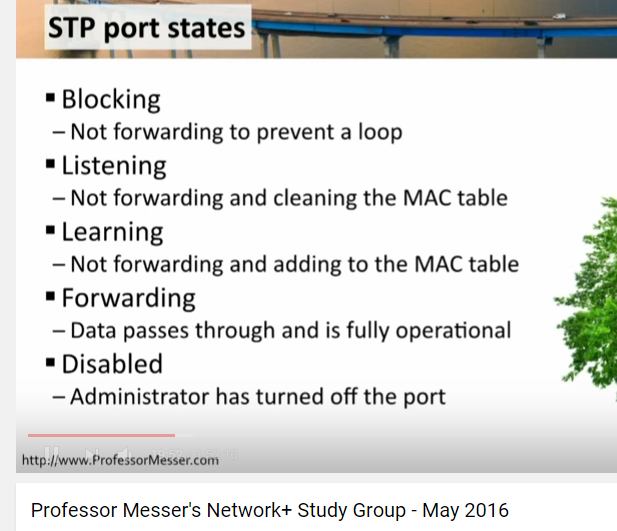Spanning Tree Protocol (STP)
The Spanning Tree Protocol (STP) runs at layer 2 and is designed to prevent loops on a network that could occur if you connect a number of switches together. For example, a loop is created if you connect Switch1 to Switch2 and then turn around and connect Switch2 back to Switch1 using a different cable and ports on the switches. Having a loop on the network could cause the network to go down and creates instability in the switches. To prevent this, STP was designed. STP is a protocol that looks at all of the ports used to create a loop and then places one of those ports in a blocking state so that no data traffic can pass through the port. Once the port is in a blocking state, the loop is broken and the network becomes more stable. The fact that the port is in a blocking state instead of being disabled means that if one of the other links go down, then the port is transitioned into a forwarding state automatically. When a port is in a forwarding state, it is allowed to send and receive
data on the port.
Switching Loops Today’s networks often connect switches with redundant links to
provide for fault tolerance and load balancing. Protocols such as Spanning Tree Protocol
(STP) prevent switching loops and simultaneously maintain fault tolerance. If STP fails,
it takes some expertise to reconfi gure and repair the network, so you just need to be
concerned with being able to identify the problem so you can escalate it. Remember, when
you hear users complaining that the network works fi ne for a while, then unexpectedly
goes down for about a minute, and then goes back to being fi ne, it’s defi nitely an STP
convergence issue that’s pretty tough to fi nd and fi x. Escalate this problem ASAP!
data on the port.
Switching Loops Today’s networks often connect switches with redundant links to
provide for fault tolerance and load balancing. Protocols such as Spanning Tree Protocol
(STP) prevent switching loops and simultaneously maintain fault tolerance. If STP fails,
it takes some expertise to reconfi gure and repair the network, so you just need to be
concerned with being able to identify the problem so you can escalate it. Remember, when
you hear users complaining that the network works fi ne for a while, then unexpectedly
goes down for about a minute, and then goes back to being fi ne, it’s defi nitely an STP
convergence issue that’s pretty tough to fi nd and fi x. Escalate this problem ASAP!


